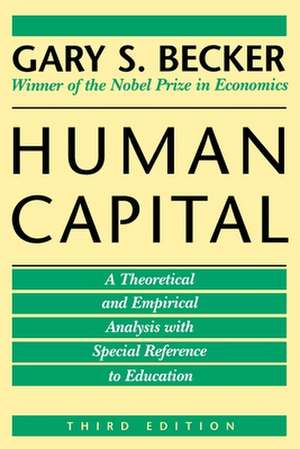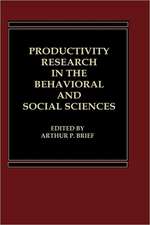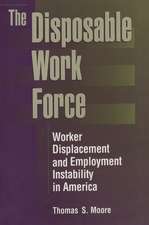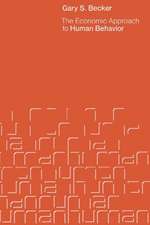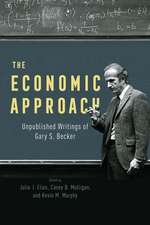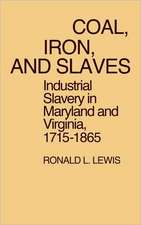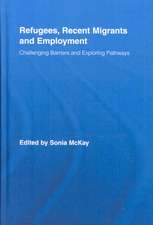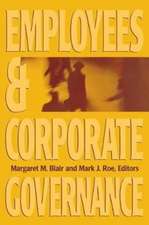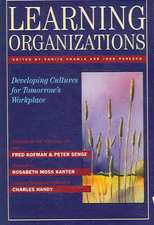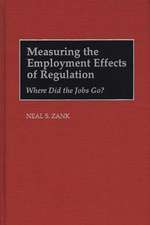Human Capital: A Theoretical and Empirical Analysis, with Special Reference to Education, 3rd Edition
Autor Gary S. Beckeren Limba Engleză Paperback – 14 mar 1994
Human Capital is Becker's classic study of how investment in an individual's education and training is similar to business investments in equipment. Recipient of the 1992 Nobel Prize in Economic Science, Gary S. Becker is a pioneer of applying economic analysis to human behavior in such areas as discrimination, marriage, family relations, and education. Becker's research on human capital was considered by the Nobel committee to be his most noteworthy contribution to economics.
This expanded edition includes four new chapters, covering recent ideas about human capital, fertility and economic growth, the division of labor, economic considerations within the family, and inequality in earnings.
"Critics have charged that Mr. Becker's style of thinking reduces humans to economic entities. Nothing could be further from the truth. Mr. Becker gives people credit for having the power to reason and seek out their own best destiny."—Wall Street Journal
This expanded edition includes four new chapters, covering recent ideas about human capital, fertility and economic growth, the division of labor, economic considerations within the family, and inequality in earnings.
"Critics have charged that Mr. Becker's style of thinking reduces humans to economic entities. Nothing could be further from the truth. Mr. Becker gives people credit for having the power to reason and seek out their own best destiny."—Wall Street Journal
Preț: 209.45 lei
Nou
Puncte Express: 314
Preț estimativ în valută:
40.08€ • 41.61$ • 33.42£
40.08€ • 41.61$ • 33.42£
Carte disponibilă
Livrare economică 04-18 martie
Livrare express 15-21 februarie pentru 31.78 lei
Preluare comenzi: 021 569.72.76
Specificații
ISBN-13: 9780226041209
ISBN-10: 0226041204
Pagini: 412
Ilustrații: 6 line drawings, 2 tables
Dimensiuni: 152 x 229 x 25 mm
Greutate: 0.57 kg
Ediția:3
Editura: University of Chicago Press
Colecția University of Chicago Press
Locul publicării:Chicago, IL, United States
ISBN-10: 0226041204
Pagini: 412
Ilustrații: 6 line drawings, 2 tables
Dimensiuni: 152 x 229 x 25 mm
Greutate: 0.57 kg
Ediția:3
Editura: University of Chicago Press
Colecția University of Chicago Press
Locul publicării:Chicago, IL, United States
Public țintă
Academic/professional/technical: Undergraduate. Academic/professional/technical: Postgraduate. Academic/professional/technical: Research and professionalCuprins
List of Tables
List of Charts
Preface to the Third Edition
Preface to the First Edition
I. Introduction to the Second Edition
Introduction to the First Edition
II. Human Capital Revisited
1. Introduction
2. Education and Training
3. Human Capital and the Family
4. Human Capital and Economic Development
5. Conclusions
6. References
Part One: Theoretical Analysis
III. Investment in Human Capital: Effects on Earnings
1. On-the-Job Training
General Training
Specific Training
2. Schooling
3. Other Knowledge
4. Productive Wages Increases
IV. Investment in Human Capital: Rates of Return
1. Relation between Earnings, Costs, and Rates of Return
Addendum: The Allocation of Time and Goods over Time
2. The Incentive to Invest
Number of Periods
Wage Differentials and Secular Changes
Risk and Liquidity
Capital Markets and Knowledge
3. Some Effects of Human Capital
Examples
Ability and the Distribution of Earnings
Addendum: Education and the Distribution of Earnings: A Statistical Formulation
Addendum: Human Capital and the Personal
Distribution of Income: An Analytical Approach
Supplement: Estimating the Effect of Family Backgrounds on Earnings
Part Two: Empirical Analysis
V. Rates of Return from College Education
1. Money Rates of Return to White Male College Graduates
Returns in 1939
Costs in 1939
Rates of Return in 1939
Rates of Return in 1949
2. Some Conceptual Difficulties
Correlation between "Ability" and Education
Correlation between Education and Other Human Capital
3. Rates of Return to Other College Persons
College Dropouts
Nonwhites
Women
Rural Persons
4. Variation in Rates of Return
VI. Underinvestment in College Education?
1. Private Money Gains
2. Social Productivity Gains
3. Private Real Rates
VII. Rates of Return from High School Education and Trends over Time
1. The Rate of Return from High School Education
2. Trends in Rates of Return
After 1939
Before 1939
VIII. Age, Earnings, Wealth, and Human Capital
1. Age-Earnings Profiles
2. Age-Wealth Profiles
IX. Summary and Conclusions
1. Summary
2. Future Research
3. Concluding Comments
Part Three: Economy-Wide Changes
Introduction
X. Human Capital and the Rise and Fall of Families, by Gary S. Becker and Nigel Tomes
1. Introduction
2. Earnings and Human Capital
Perfect Capital Markets
Imperfect Access to Capital
3. Assets and Consumption
4. Fertility and Marriage
5. Empirical Studies
6. Summary and Discussion
References
XI. The Division of Labor, Coordination Costs, and Knowledge, by Gary S. Becker and Kevin M. Murphy
1. Introduction
2. Division of Labor among Tasks
3. Coordination Costs
4. Knowledge and Specialization
5. Extent of the Market
6. The Growth in Specialization and Knowledge
7. The Division of Labor between Sectors: Teachers and Workers
8. Summary
Appendix
References
XII. Human Capital, Fertility, and Economic Growth, by Gary S. Becker, Kevin M. Murphy, and Robert Tamura
1. Introduction
2. Basic Properties of the Model
3. Fertility and Growth
4. Comparative Advantage in the Production of Human Capital
5. Discussion
6. Concluding Remarks
References
Appendixes
A. Sources and Methods
1. Incomes
a. The Basic Data
b. Under- and Overreporting
c. Unemployment
d. Coverage in 1939
e. Taxes
f. Urban-Rural Distribution
g. Hours of Work
2. Costs
a. Earnings of Students
b. Direct Private Costs
c. Direct Social Costs
B. Mathematical Discussion of Relation between Age, Earnings, and Wealth
Author Index
Subject Index
List of Charts
Preface to the Third Edition
Preface to the First Edition
I. Introduction to the Second Edition
Introduction to the First Edition
II. Human Capital Revisited
1. Introduction
2. Education and Training
3. Human Capital and the Family
4. Human Capital and Economic Development
5. Conclusions
6. References
Part One: Theoretical Analysis
III. Investment in Human Capital: Effects on Earnings
1. On-the-Job Training
General Training
Specific Training
2. Schooling
3. Other Knowledge
4. Productive Wages Increases
IV. Investment in Human Capital: Rates of Return
1. Relation between Earnings, Costs, and Rates of Return
Addendum: The Allocation of Time and Goods over Time
2. The Incentive to Invest
Number of Periods
Wage Differentials and Secular Changes
Risk and Liquidity
Capital Markets and Knowledge
3. Some Effects of Human Capital
Examples
Ability and the Distribution of Earnings
Addendum: Education and the Distribution of Earnings: A Statistical Formulation
Addendum: Human Capital and the Personal
Distribution of Income: An Analytical Approach
Supplement: Estimating the Effect of Family Backgrounds on Earnings
Part Two: Empirical Analysis
V. Rates of Return from College Education
1. Money Rates of Return to White Male College Graduates
Returns in 1939
Costs in 1939
Rates of Return in 1939
Rates of Return in 1949
2. Some Conceptual Difficulties
Correlation between "Ability" and Education
Correlation between Education and Other Human Capital
3. Rates of Return to Other College Persons
College Dropouts
Nonwhites
Women
Rural Persons
4. Variation in Rates of Return
VI. Underinvestment in College Education?
1. Private Money Gains
2. Social Productivity Gains
3. Private Real Rates
VII. Rates of Return from High School Education and Trends over Time
1. The Rate of Return from High School Education
2. Trends in Rates of Return
After 1939
Before 1939
VIII. Age, Earnings, Wealth, and Human Capital
1. Age-Earnings Profiles
2. Age-Wealth Profiles
IX. Summary and Conclusions
1. Summary
2. Future Research
3. Concluding Comments
Part Three: Economy-Wide Changes
Introduction
X. Human Capital and the Rise and Fall of Families, by Gary S. Becker and Nigel Tomes
1. Introduction
2. Earnings and Human Capital
Perfect Capital Markets
Imperfect Access to Capital
3. Assets and Consumption
4. Fertility and Marriage
5. Empirical Studies
6. Summary and Discussion
References
XI. The Division of Labor, Coordination Costs, and Knowledge, by Gary S. Becker and Kevin M. Murphy
1. Introduction
2. Division of Labor among Tasks
3. Coordination Costs
4. Knowledge and Specialization
5. Extent of the Market
6. The Growth in Specialization and Knowledge
7. The Division of Labor between Sectors: Teachers and Workers
8. Summary
Appendix
References
XII. Human Capital, Fertility, and Economic Growth, by Gary S. Becker, Kevin M. Murphy, and Robert Tamura
1. Introduction
2. Basic Properties of the Model
3. Fertility and Growth
4. Comparative Advantage in the Production of Human Capital
5. Discussion
6. Concluding Remarks
References
Appendixes
A. Sources and Methods
1. Incomes
a. The Basic Data
b. Under- and Overreporting
c. Unemployment
d. Coverage in 1939
e. Taxes
f. Urban-Rural Distribution
g. Hours of Work
2. Costs
a. Earnings of Students
b. Direct Private Costs
c. Direct Social Costs
B. Mathematical Discussion of Relation between Age, Earnings, and Wealth
Author Index
Subject Index
